When we created SendView, one of our goals was to create a way for marketers to better track the email marketing journeys of their competitors. These journeys are really hard to track in an inbox like Gmail that’s built for reading emails instead of analyzing from them, so we set out to build an interface that was designed for tracking journeys and learning from their tactics. Designing and implementing an effective email customer journey is crucial, as it requires strategic planning, automation, and ongoing optimization to maximize engagement and conversions.
Simply put, an email marketing journey is a marketing campaign that sends automated email marketing campaigns to your target audience over time. More specifically, an email customer journey is a strategic framework that guides your marketing efforts through various stages—such as awareness, consideration, decision, retention, and advocacy—by creating meaningful touchpoints and targeted campaigns throughout the customer's experience with your brand. Journeys inform strategies to attract leads, nurture customers, educate prospects, or encourage subscribers to take action through emails.
Businesses use customer journey mapping to strategically plan email subscriber experiences through visual representations of customer interactions – a journey map. This process helps marketers understand the marketing customer journey, which is the complete lifecycle of customer interactions through strategic email campaigns, ensuring personalized touchpoints at every stage. Email journeys allow digital marketers to create a sense of personalization, build brand loyalty, and save time while increasing engagement and revenue.
This complete guide will walk you through how to plan an effective email journey. Plus, we’ll cover what a customer journey is, why you need one, and the dos and don’ts of a compelling strategy.
Pull out your whiteboard and get ready to map. First, let’s begin with the basics.
Introduction to Customer Journeys
Customer journeys are a crucial aspect of any successful email marketing strategy. By mapping out the path a customer takes from their first interaction with your brand to becoming a loyal advocate, businesses can deliver a series of tailored experiences that keep customers engaged at every stage. Understanding the customer’s journey allows marketers to send personalized emails that address individual needs, interests, and behaviors—making each interaction feel relevant and valuable.
A well-planned customer journey doesn’t just boost customer satisfaction; it also encourages customers to become long-term supporters of your brand. By guiding subscribers from the brand awareness stage through to long-term loyalty, your email marketing can nurture relationships, build trust, and ultimately drive more conversions. Incorporating customer journeys into your marketing strategy ensures that every email you send is purposeful and aligned with your customers’ evolving needs.
What is an email journey?
An email journey is a series of automated emails that are sent over a period of time, triggered by specific user behaviors. They can attract leads, nurture customers, educate prospects, or encourage subscribers to take action. Customer email journeys are sometimes called programs, emails series, or even autoresponders depending on the context or the industry you’re working in. In some cases, email journeys are used to describe must larger maps of email campaigns. In this case, these other concepts may be parts of an overall customer journey rather than a synonym for this idea.
In the case of , we went with the name “Timelines” to describe the interface our customers can use to browse their competitors’ email marketing journeys because they may look at the full journey or simply evaluate specific series or program within it.
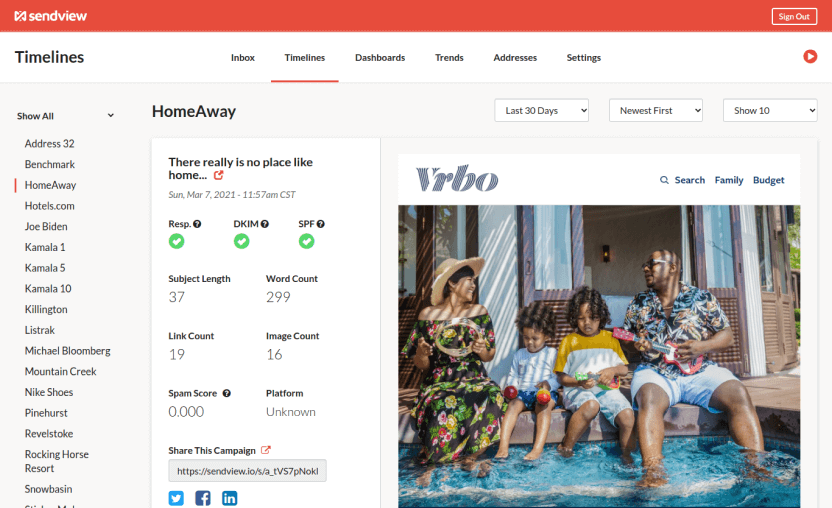
Timelines are a way to view the sequences of emails that a company sends one after the other. Email journey mapping helps design and track personalized email interactions across different customer journey stages, making it easier to enhance targeted communication and engagement at each touchpoint. Each email in the journey (or timeline) can be shared with your team, downloaded, or edited in Parcel. You can also toggle between desktop and mobile view, see the HTML, and track key stats - like how many days pass between when each email in a journey is sent - all from the Timelines page.
What is customer journey email mapping?
Customer journey mapping is a tool businesses use to plan customer experiences strategically. A customer journey map is a visual or strategic tool that outlines and guides the entire customer experience, visually representing each customer interaction with a company, from initial contact to post-purchase follow-up. By mapping out customer and lead touchpoints, businesses can identify opportunities to improve their processes and meet customer needs.
For example, if you understand a potential customers’ knowledge of your products when you capture their email, a journey may involve building interest, awareness, social proof, urgency, resolving concerns, and more through various campaigns before leading to a more clear, specific call-to-action designed to drive revenue. Even then, an email journey may continue long after that first call to action in order to keep them engaged and increase the likelihood that person will buy the next time they send an offer whether it was a planned part of the journey or not.
Why do email marketers need to map email journeys?
Email journeys enable digital marketers to foster relationships with their customers and cultivate loyalty. They can create a sense of personalization and build excitement as customers move through the funnel, increasing the likelihood of interacting with the content and ultimately making a purchase. A well-defined email strategy is essential for planning and executing these journeys, ensuring that each step is purposeful and aligned with customer needs. Email journeys can – and should – be customized to match individual customers’ unique interests and preferences.
For example, an email marketing journey might be very for a family versus an individual if you’re selling something like travel, food, or clothing. The emails you send to someone might be very different for someone who is very familiar with your products versus someone who is encountering them for the first time. Likewise, if someone is showing a lot of intent that email journey may look different than the group of folks who are casual browsing your site or content.
The Benefits of an Email Journey
A well-designed email Journey is a powerful marketing and customer engagement tool. One step further, visual journey maps are an additional tool businesses can use to create strategic emails to push their customers through the funnel. Automating this journey allows them to efficiently reach their target audience with relevant and engaging emails. Tracking click through rates during these journeys helps measure the effectiveness of email campaigns and provides valuable insights to optimize future strategies.
#1) Email Journeys Increase Engagement
An Email Journey allows businesses to tailor their emails to their customers, encouraging them to take action. This personalized marketing approach helps companies to establish a more intimate relationship with their customers. Automating outreach and follow-ups can increase reply rates by 250%. To further improve email engagement, it's important to test and optimize subject lines through A/B testing, as personalized subject lines can significantly impact how recipients respond to your campaigns. It sounds simple, but it’s the foundation of virtually all marketing: if you send content that is relevant to your customers, they are more likely to engage with it (especial via email).
#2) Journeys Can Increase revenue
Digital marketers who automate their email campaigns see up to 359% higher conversion rates than one-off email campaigns. This means that businesses can quickly increase their revenue with email journeys. At the purchase stage, which is a critical point in the customer journey, targeted emails such as reminders or special offers can drive conversions and encourage customers to complete their transactions. Remember what we said in the first point? Engagement isn’t just clicking and opening, it’s also buying. Emails that are better matched to where the customer is in their journey are more likely to be acted upon.
#3) Journeys Can Build Brand Loyalty
Customized, consistent emails sent strategically make subscribers feel like they are part of a special club, increasing loyalty. Engaging existing customers in advocacy efforts is crucial, as satisfied customers are more likely to recommend the brand to friends and family. Implementing loyalty rewards and referral programs within your email strategy can incentivize these satisfied customers to promote your brand and share their positive experiences with others. This is especially true when your email journey accounts for what happens after someone buys your products, services, or experiences.
#4) Email Automations Can Save Time
Email marketing automations with the right dynamic content blocks can save email marketers 6 hours per week on average. That gives any email team more time to leverage other conversion methods and increase revenue elsewhere. Automated email campaigns can efficiently nurture customer relationships and encourage advocacy by prompting referrals, testimonials, and social media sharing. The more of these automated campaigns you can include in your journey, the more pressure is taken off your team to constantly deliver one-off campaigns to stay engaged with your email database.
#5) Journeys Can Increase Personalization
One of the most powerful advantages of customer journeys is the ability to deliver highly personalized email marketing campaigns. By leveraging customer data and analyzing customer behavior, businesses can create targeted emails that speak directly to each subscriber’s interests and pain points. This means you can send relevant messages, exclusive offers, and content that truly resonates with your audience.
Personalized emails not only make customers feel valued but also increase the likelihood of engagement and conversion. When your email marketing campaigns are tailored to individual preferences and past interactions, you build trust and strengthen the relationship between your brand and your customers. Over time, this approach leads to higher customer retention, as recipients are more likely to stay engaged with a brand that consistently meets their needs.
Understanding the Buying Process
The buying process is a fundamental part of the customer journey, encompassing several key stages that every customer goes through before making a purchase. From the initial moment of brand awareness to the final decision and beyond, each stage presents unique opportunities—and challenges—for marketers.
To create effective email marketing campaigns, it’s essential to understand how customers behave at each step of the buying process. By analyzing customer behavior, you can identify where potential customers might hesitate or drop off, such as during a complicated checkout process or when comparing options. Use this insight to guide customers with helpful tips, clear calls-to-action, and timely support. By addressing obstacles and providing value at every stage, your email marketing can smooth the path to purchase and enhance the overall customer experience.
Brand Awareness and Consideration
The brand awareness and consideration stages are where the customer journey begins. At this point, potential customers are just discovering your brand and starting to learn about what you offer. Email marketing is a powerful tool for making a memorable first impression and nurturing interest.
During these early stages, focus your email campaigns on introducing your brand, sharing customer testimonials, and providing valuable content that answers common questions or solves problems. Highlight what sets your products or services apart and encourage customers to take the next step, whether that’s exploring your website, signing up for early access, or downloading a helpful guide. By engaging potential customers with relevant, trustworthy information, you lay the foundation for them to become loyal customers as they move further along their journey.
#5) Journeys Can Increase Personalizion
Email Journeys enable businesses to create email content that is highly targeted. They can easily segment their list based on customer data, such as purchase history and past purchases, to tailor recommendations and content that resonate with each recipient. Creating personalized emails to specific customer segments—based on shopping or browsing patterns, or other general user data like their name or location—can significantly increase engagement. Additionally, offering exclusive content as a reward or perk can deepen customer relationships and encourage ongoing interaction with your brand. Also, remember that email journeys can and should account for how they engage at each phase of the journey. Use this information to personalize what they see later.
How long should an email journey be?
The length of an email journey can vary significantly depending on the goals and audience of the campaign. Generally, keep email journeys as short as possible; each email should have a clear and specific purpose. An email journey can comprise as few as two emails and as many as six emails. Each step or phase in the journey is part of a broader email marketing campaign designed to nurture customers, guiding them through different stages of engagement and conversion. That said, let the bandwidth your team has and the unique goals within your business dictate the right length for the journey.
I’ve worked in complex, B2B marketing where we’re designing year-long nurturing journeys with dozens of campaigns. I’ve also worked with simple, retail products where I can do what I need within 2-3 campaigns.
How to create and use your customer email journey map
We’ll talk about creating an email journey next, but first, let’s familiarize ourselves with the traditional marketing funnel. Mapping the customer's journey is essential for optimizing email marketing efforts, as it allows you to tailor communication strategies at each stage and improve retention and engagement. Email journeys can serve different purposes. Each one of those purposes will start at a different point in the funnel.
Start with your marketing funnel.
A marketing funnel outlines your customer’s email journey from the first time they hear about your company to when they purchase. It’s essential to meet your subscribers where they’re at in the funnel.
The six, primary stages of a simple marketing funnel are:
- Awareness - someone hears about you for the first time.
- Interest - you start to get them curious about what your product could do for their life.
- Consideration stage - at this point, the potential customer starts thinking about buying a new product or service, might research, be nurtured, or need to hear about you multiple times in this phase to move on to the next phase. This is where prospects evaluate and compare their options.
- Acquisition - conversion copy, ads, marketing emails, and more will convert someone from considering to a new customer. Understanding the potential customer and analyzing when a customer makes a purchase is crucial in this phase to tailor your marketing efforts and remove obstacles to the sale.
- Retention - they’re already your customer; now you want to keep them around and potentially buy more from you.
- Advocacy - the customer loves your brand so much that they recommend it.
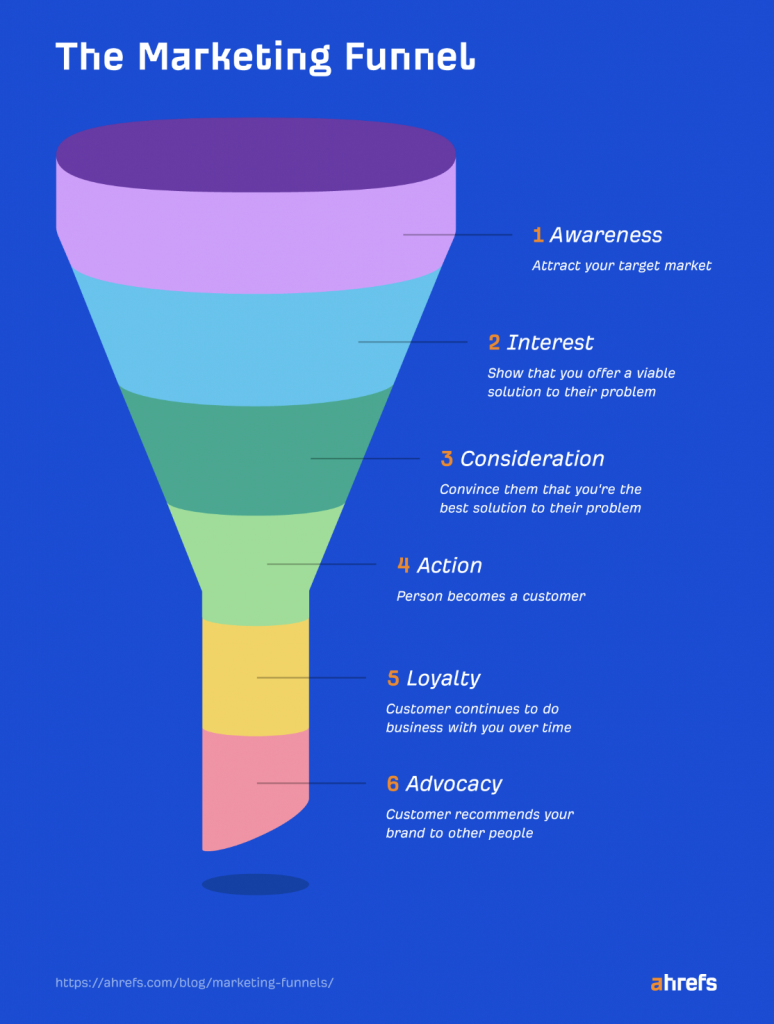
https://ahrefs.com/blog/marketing-funnels/
Step 1: define your goals
You can make dozens of email journeys if you want to. Many successful companies do! Before creating your first email journey, consider what you want to achieve. Also, consider where your customer is in your funnel and meet them there.
You might want to get someone from the awareness phase of the funnel to the consideration phase. Maybe you want to nurture someone who’s abandoned their cart to purchase what they left behind. Perhaps you want them to refer their friends after they buy a product. You could aim to educate them after they sign up for a discount code. Welcoming a new subscriber with an onboarding sequence or a welcome email is also essential for introducing your brand and fostering early engagement.
Here are 18 types of user journey automations you can use to grow your email marketing strategy:
- brand awareness
- lead acquisition
- research
- comparison
- purchase
- onboarding or education
- new subscriber onboarding
- upsells
- cross-sells
- retention and loyalty
- advocacy
- abandoned cart
- re-engagement or win back
- next steps
- reminders
- birthday offers
- VIP offers
- feedback
- welcome series
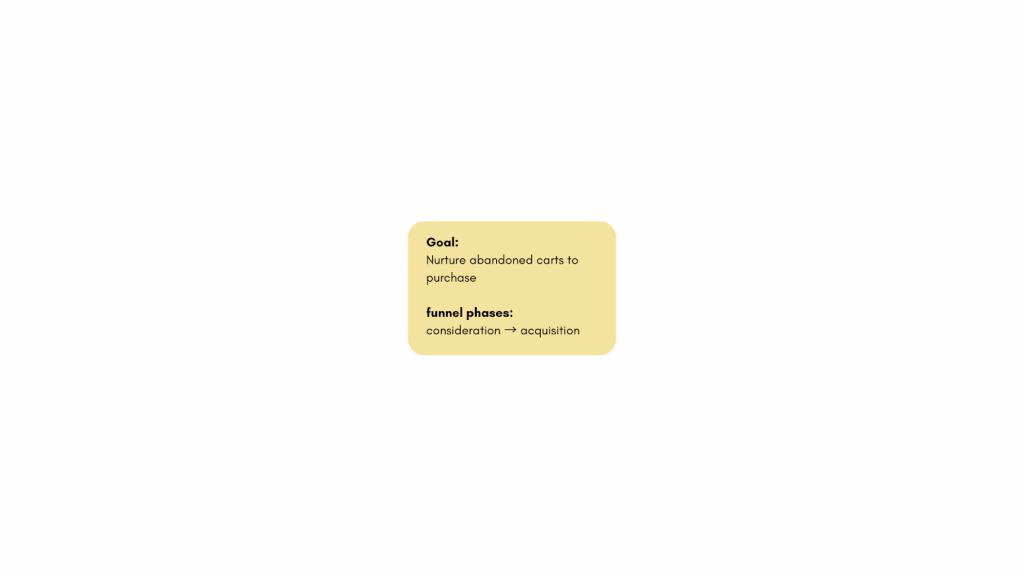
Step 2: Create a strategy
For each of your goals, you’ll need to come up with a strategy to achieve them. In this phase, create a list of steps to take them from where they are in the funnel to where you want them to go. Incorporate targeted email strategies at each stage to effectively guide customers through their journey and maximize engagement. Then, plan one email idea for each of those steps.
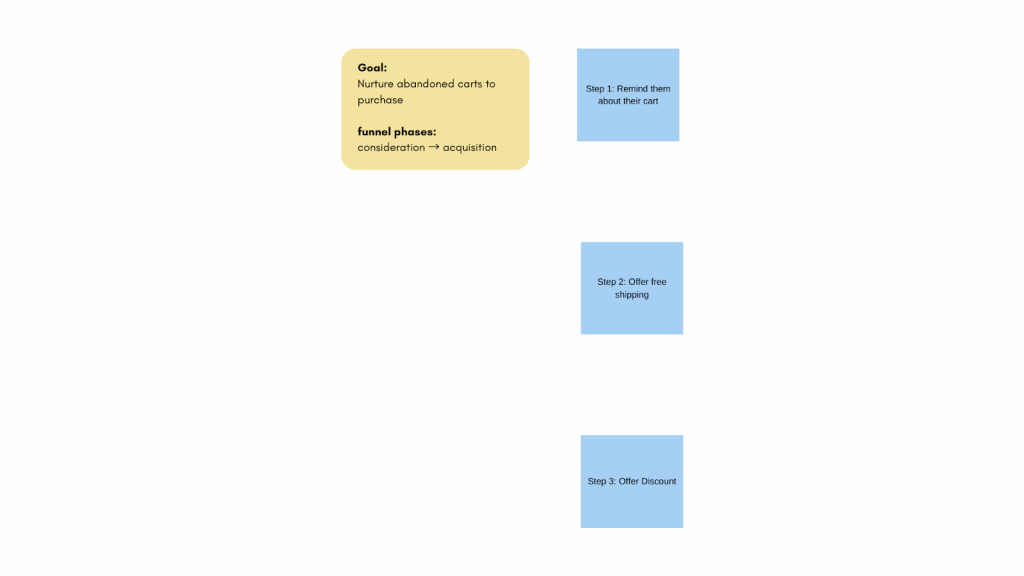
Step 3: Plan your automation
Now that you know which emails you want to send, think about how you’ll create a workflow for that email. You’ll need rules and triggers that indicate to your email marketing software (EMS) what actions will add people to this workflow and the intervals at which it will send your emails. An email marketing tool can streamline automation, segmentation, and analytics, making it easier to build effective workflows and improve your campaign performance.
List out the following to prepare your automation sequence:
- What segment will these subscribers be added to?
- How often will you send your emails?
- What will your subscriber’s actions lead to?
- At any point will some subscribers be removed from this workflow?
- Are there places where you want to include multiple if/then options?
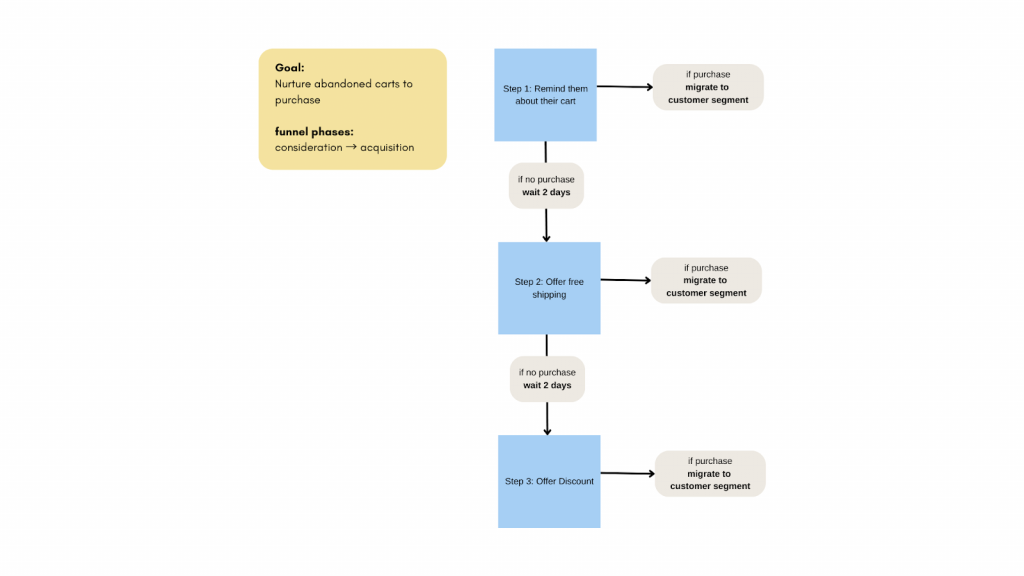
Step 4: Create content
Now you know which emails you need to create and how you’ll lay them out in your EMS. It’s time to create the actual emails that you’ll send! Use personalization and dynamic content blocks to boost loyalty and conversions wherever possible.
Think about the pain points of the audience you’re trying to reach. Are they existing customers, new customers, new subscribers, or referrals? For new subscribers, sending a well-crafted welcome email is essential to introduce your brand and encourage early engagement. To win back lapsed customers, consider using a re engagement email with personalized content and clear calls to action. For VIP customers, implement exclusive offers and personalized communication to foster loyalty. Make sure your content strategy appeals to both new and existing customers to maximize retention. Also, map out the key touchpoints where customers interact with your brand throughout their journey, as these interactions influence their experience and behavior. The user experience will be the difference between an effective journey and an annoying one.
Here are some examples ofgreat abandoned cart emails from our friends at Really Good Emails:
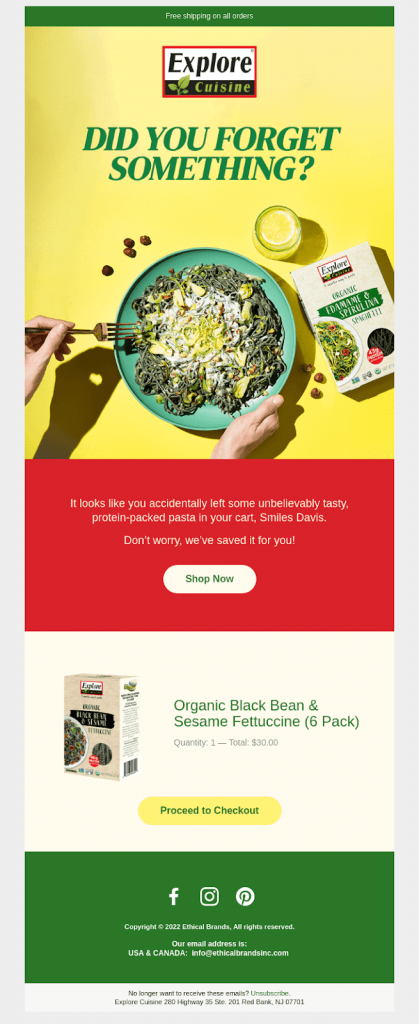

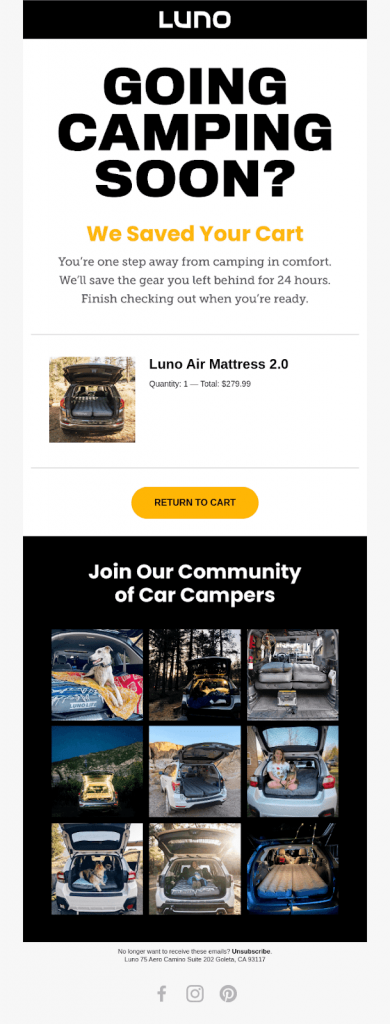
Step 5: Build the automation in your email marketing system
Automating your email marketing campaigns is essential for delivering effective customer journeys. By building automation into your email marketing system, you ensure that each customer receives the right message at the right time, based on their actions and stage in the journey. This not only saves your team valuable time but also allows you to provide a seamless, personalized experience for every subscriber.
With automation, you can set up complex email journeys that include welcome emails for new subscribers, abandoned cart reminders for potential customers, and automated re-engagement emails for lapsed or inactive customers. Each automated campaign is designed to guide customers through their journey, nurture relationships, and foster long-term loyalty. By leveraging automation, you can keep customers engaged, encourage repeat purchases, and build a loyal customer base—all while scaling your email marketing efforts efficiently.
Step 5: Built the automation in your email marketing system
You’ve done the hard work. Now all that’s left is bringing it together in your EMS. Build an automation workflow out of your newly minted content, the triggers and rules you planned, and the segments you outlined. As you watch the change it creates over the next few months, use analytics to identify trends in customer behavior and campaign performance, helping you optimize your strategy for better results!
Customer/email/User journey example
Let’s put it all together now! Here’s the complete example of an abandoned cart email journey map from start to finish.
- Goal: nurture abandoned carts to purchase
- Funnel phases: consideration → acquisition
- Strategy: automate reminders, offer discounts, offer free shipping
- Automation plan: wait two days between each email, and matriculate users into customer segments once they buy
- Content: reminder email, free shipping email, discount email
After a customer completes a purchase, send a follow-up email requesting online reviews. This helps gather valuable feedback, address pain points, and build trust for future customers.
We planned this out on a Canva Whiteboard, but you could also use Miro, paper and a pen, a real whiteboard, or another similar tool! It’s easy to create a quick visual map of these ideas once you know the process.
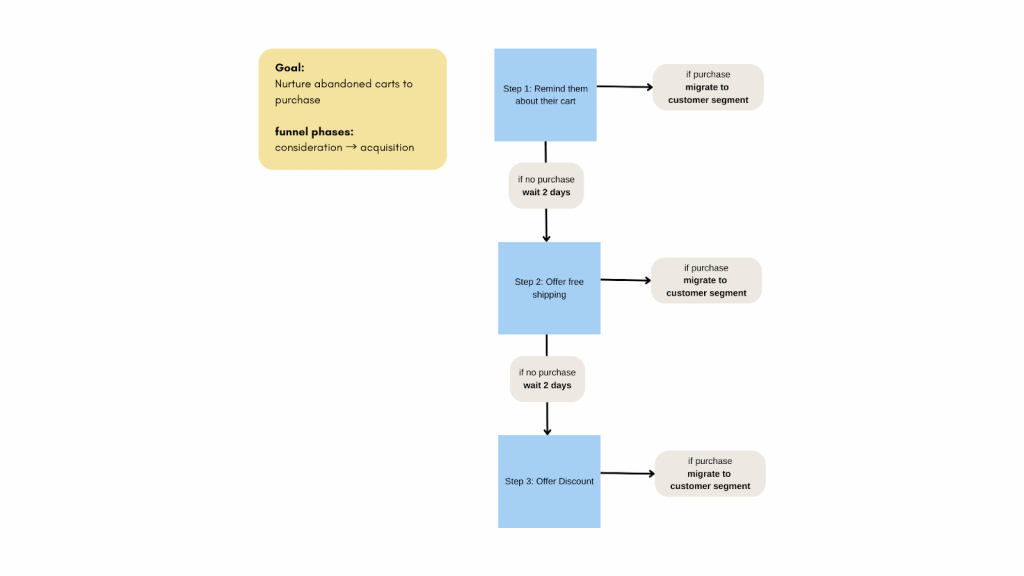
Email Journey Dos and Don'ts
Now you know how to create an email journey! But before you go, there are a few dos and don’ts to remember when crafting an effective email journey. Targeted emails at each stage can encourage recipients to engage more deeply with your brand. Here are a few tips:
#1) Do allow self-segmentation on your subscription forms
You can segment your audience based on their preferences. This makes them more likely to open your emails, find them relevant, and eventually purchase. If you allow them to pick these interests themselves when they subscribe to your email list, rather than get annoyed by your emails, they will likely enjoy the journeys you map out for them.
#2) Don't send emails too frequently
Be timely when you're reminding subscribers of sensitive things like abandoned carts and events. But don't bombard your lists. Sending emails too frequently can annoy your subscribers and lead them to unsubscribe. Add an option to hear from you less often in your unsubscribe form if this is something you worry about! Watching your competitors' email sending frequency on the aggregate and with individual brands can help you learn from other teams who may have already found the sweet spot for your audience.
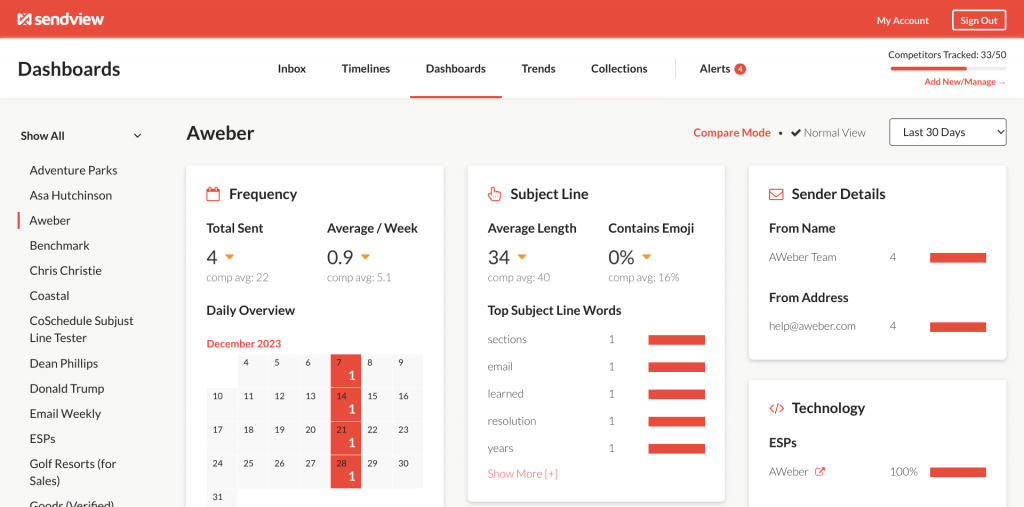
#3) Do automate
Automate your email marketing campaigns! Save yourself time and brain power by creating an automation for every email journey you have in mind. In some cases, your full customer email journey can be automated. Look for campaigns you send frequently and see if there aren't ways to automated the content, timing, or audience of each email in your journey.
#4) Don't overload your email content
Keep each email short and sweet. It's better to have more emails with less content than a few jam-packed emails. Each email should have only one obvious call to action, and no more than three bite-sized pieces of information. You can use tools like SendView's Word Count trend report to see how long your competitors' emails are and understand the context of what your audience might be used to in terms of length.
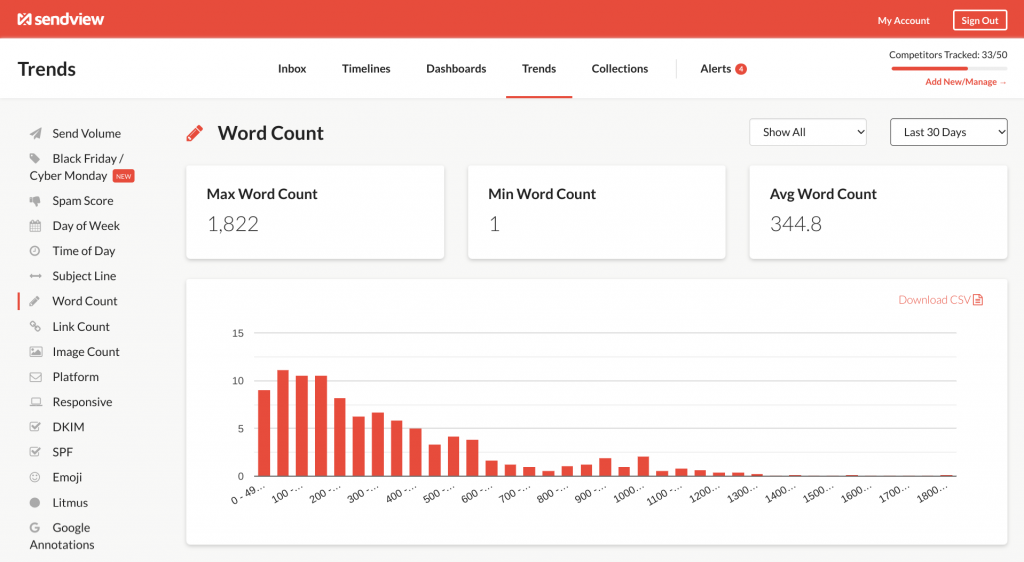
#5) Do personalize your messages
Use the subscribers' first names, suggest products they'd like based on their e-commerce habits, add them to segments based on what they've bought, and offer special deals for the products they've had their eye on. Customizing your emails with dynamic elements will make your customer feel seen and increase your conversion rates.
#6) Don't ignore the data
Look through customer feedback, check the metrics on your automations, and track your customer's actions in your e-commerce platform to optimize your email journey results. Even making small tweaks can lead to big results in email automations. Try some A/B testing while you're at it! Testing at least once every six months is necessary.
Get insights on your competitors' customer journey mapping.
Need inspiration for your own customer journey mapping? Want to see what your competitors are up to? You can use Sendview to track your competitors’ email marketing strategy! By analyzing their journeys, you can gain valuable insights to optimize your own email marketing approach.
With trend reports, email timelines, detailed company comparisons, and split test programs, you can see it all on your Sendview dashboard. Let’s look at a few of those features.
1) Track the Timing of Your Competitors' Marketing Journeys
How frequently a company sends emails is a key decision with an email marketing journey. You don't want to overwhelm your customer but you also don't want those customers to forget about you or not be able to remember your previous messages and connect all the dots. One simple way to see the timing your competitors' use within their customer journey strategy is the Send Volume report in the Trends section of your SendView account.
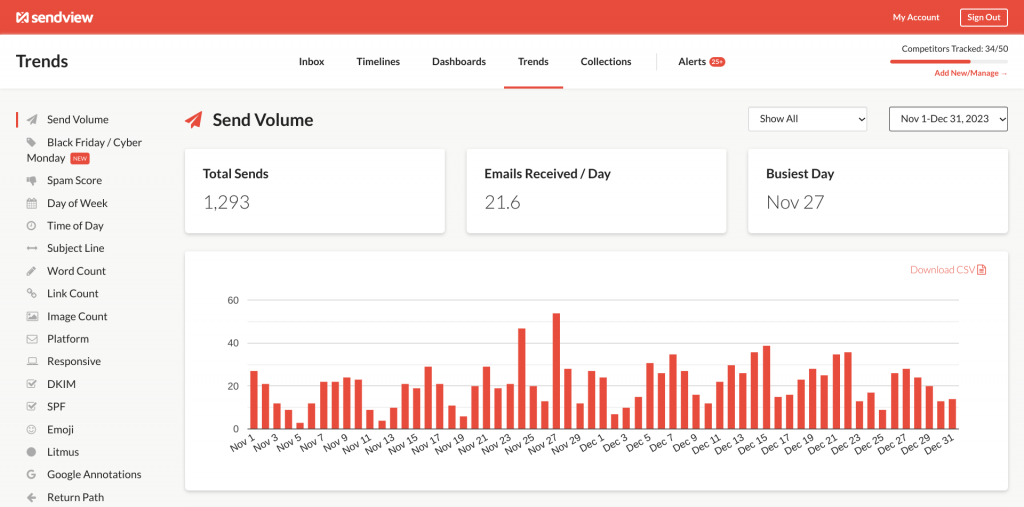
You can see how frequently your competitors send email campaigns on the aggregate during any stretch of the email journey, but don't forget to scroll down so you can see these stats for each individual sender as well.
2) Email Journey Calendar View
As we've just discussed, timing is a key aspect of a company's strategy around the customer journey. In your SendView account you can use the calendar view in any competitor's Dashboard to see the exact timing of a series of email marketing campaigns on a simple calendar. This allows you to really get a feel of where the frequency overlaps with the most common days of the week they like to send emails. This will give you a visual view of an email program.
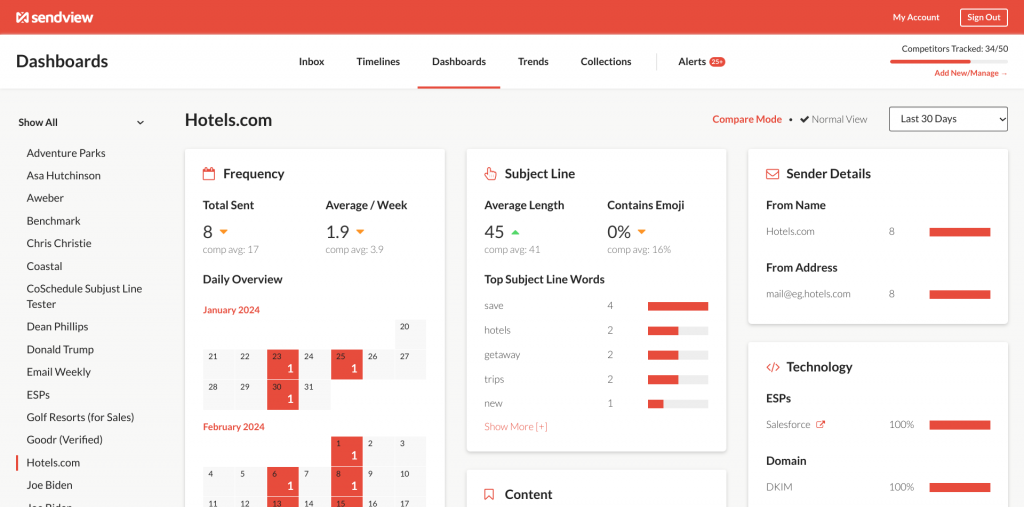
Now, that's great to see and you can start to get a feel for how they are balancing timing and frequency with the design of their email journey, but you can also view these calendars side-by-side with the comparison feature within the Dashboards feature.
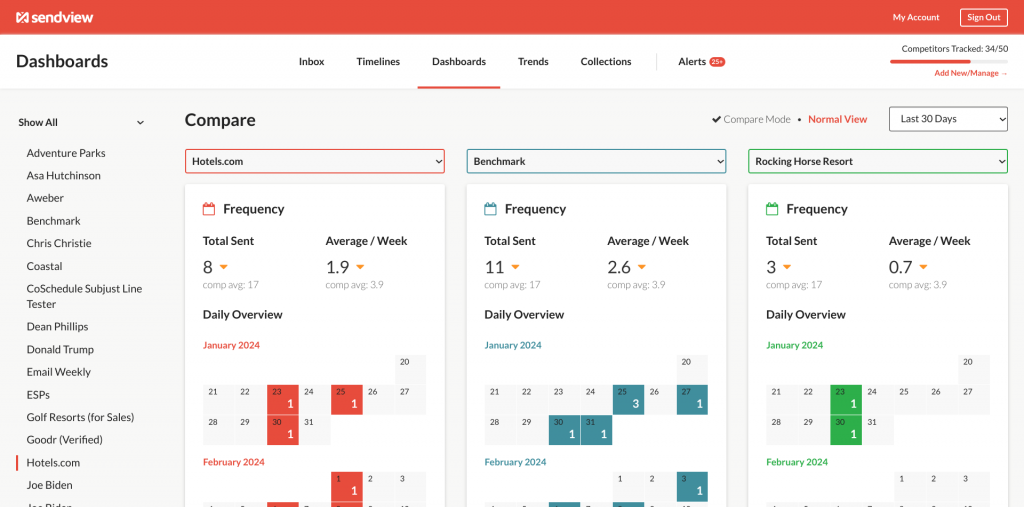
It's one of my favorite features because it lets you visually compare each company's strategy as they communicate with their audience.
3) Visual Timeline of Email Journeys
The previous features are giving you a nice high level view of an email journey, but nothing beats just scrolling through the emails themselves and seeing exactly how the subject line, imagery, copy, calls-to-action, and more compare from one email to the next.

Even more, with each email you can preview the email on mobile, see the source code, share the email campaigns with your team, add a campaign to a collection or your Favorites, and start to dig into each phase of your competitors' email journeys from the timing of each email to the exact purpose of one campaign to the news.
Track Your Competitors' Email Journeys with SendView
a powerful tool that allows you to make strategic decisions and follow your competitors' email journeys from the moment you subscribe to their emails. For example, the Timelines feature allows you to see the full HTML of each email in a journey in sequence, how many days pass between campaigns, see how each email looks on mobile, dig into the source code, and more.
Want to track your competitors' email journeys? You're just a few minutes away from getting started, just start a free trial of SendView!


 Gregg Blanchard July 25, 2025
Gregg Blanchard July 25, 2025